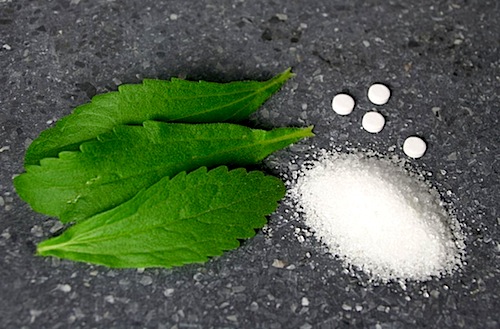|
|
Developmental Biology - Gut Microbiota
Low-calorie Sweeteners Risky for Infants
New research shows the impact 'diet' ingredients have on body weight and gut microbiota...
Many people turn to artificial or so-called natural sweeteners to cut calories and lose weight. However, a new study led by Raylene Reimer PhD, and published in the journal Gut has discovered something else.
Drinking low-calorie sweeteners while pregnant increased body fat in that mother's children, disrupting their gut microbiota. Microbiota are the trillions of bacteria and other microorganisms living in our intestinal tract to assist breaking down food into usuable nutrients. Therefore, they affect our health and risk for disease.
"Low-calorie sweeteners are considered safe to consume during pregnancy and lactation, however evidence is emerging from human studies to suggest they may increase body weight and other cardiovascular risk factors."
"Even stevia, which is hailed as a natural alternative to aspartame and other low calorie artificial sweeteners, showed a similar impact on increasing offspring obesity risk in early life."
Raylene A. Reimer PhD, Faculty of Kinesiology, University of Calgary;
Department of Biochemistry and Molecular Biology; Hotchkiss Brain Institute; International Microbiome Centre; and Department of Physiology and Pharmacology, Snyder Institute for Chronic Diseases, Cumming School of Medicine, University of Calgary, Calgary, Alberta, Canada.
Aspartame, an artificial sweetener, and stevia, a natural low-calorie sweetener extracted from a plant native to South America, are 200-400 times sweeter than sugar. Stevia was historically used in Paraguay and Brazil to treat diabetes and is an emerging ingredient in many natural products and protein drinks.
Demand for Sweeteners for Weight Loss
In response to higher obesity rates, the use of low-calorie sweeteners has increased, particularly in women and children.
Daily consumption is associated with large babies and early menstruation in young girls under 10 years - a known risk factor for chronic diseases. Additionally, some of these sweeteners have been detected in breastmilk presenting a potential mode of transmission, according to the study.
"Understanding the impact of dietary ingredients on maternal metabolism and gut microbiota may help to define the optimal maternal diet, one which promotes a healthier future for both mother and child."
Raylene A. Reimer PhD.
Altering The Gut Microbiota of Babies
Our understanding of how sweeteners affect weight gain is not complete, but there is reason to believe alterations in gut microbiota play a key role.
In this mouse animal study, a fecal transplant was used to show the direct influence of altered gut microbiota on causing the increased obesity risk.
Transplanting fecal matter from the offspring of mothers that consumed low-calorie sweeteners into sterile, germ free mouse pups caused the pups to gain more weight and have worse blood glucose control.
Even though their offspring had never consumed sweeteners themselves, changes to mom's microbiota and metabolism changed microbiota in their offspring and triggered obesity.
"A healthy pregnancy, including good nutrition, is important for a healthy baby," explains Reimer. "Our research will continue to examine what makes an optimal diet and more importantly seek to find ways to correct disruptions to gut microbiota should they occur."
These findings are significant as microbiota impact the critical early years of life, particularly during pregnancy and breast feeding.
Abstract
Objective We examined the impact of maternal low-dose aspartame and stevia consumption on adiposity, glucose tolerance, gut microbiota and mesolimbic pathway in obese dams and their offspring.
Design Following obesity induction, female Sprague-Dawley rats were allocated during pregnancy and lactation to: (1) high fat/sucrose diet (HFS) +water (obese-WTR); (2) HFS +aspartame (obese-APM; 5–7 mg/kg/day); (3) HFS +stevia (obese-STV; 2–3 mg/kg/day). Offspring were weaned onto control diet and water and followed until 18 weeks. Gut microbiota and metabolic outcomes were measured in dams and offspring. Cecal matter from offspring at weaning was used for faecal microbiota transplant (FMT) into germ-free (GF) mice.
Results Maternal APM and STV intake with a HFS diet increased body fat in offspring at weaning and body weight long-term with APM. Maternal APM/HFS consumption impaired glucose tolerance in male offspring at age 8 weeks and both APM and STV altered faecal microbiota in dams and offspring. Maternal obesity/HFS diet affected offspring adiposity and glucose tolerance more so than maternal LCS consumption at age 12 and 18 weeks. APM and STV altered expression of genes in the mesolimbic reward system that may promote consumption of a palatable diet. GF mice receiving an FMT from obese-APM and obese-STV offspring had greater weight gain and body fat and impaired glucose tolerance compared with obese-WTR.
Conclusion Maternal low-calorie sweetener consumption alongside HFS may disrupt weight regulation, glucose control and gut microbiota in dams and their offspring most notably in early life despite no direct low-calorie sweetener consumption by offspring.
This is an open access article distributed in accordance with the Creative Commons Attribution Non Commercial (CC BY-NC 4.0) license, which permits others to distribute, remix, adapt, build upon this work non-commercially, and license their derivative works on different terms, provided the original work is properly cited, appropriate credit is given, any changes made indicated, and the use is non-commercial.
Authors
Jodi E Nettleton, Nicole A Cho, Teja Klancic, Alissa C Nicolucci, Jane Shearer, Stephanie L Borgland, Leah A Johnston, Hena R Ramay, Erin Noye Tuplin, Faye Chleilat, Carolyn Thomson, Shyamchand Mayengbam, Kathy D McCoy and Raylene A Reimer.
Acknowledgments
About the International Microbiome Centre
The International Microbiome Centre at UCalgary is the largest microbiome research facility at an academic institution in the world. It allows us to investigate how the microbiome from various sites of the body controls organ function. Find out more about microbiome research at UCalgary.
UCalgary has partnered with the Canadian Museum of Nature in Ottawa to help people better understand the microbiome's influence on our body and disease, and how we might be able to harness the power of the microbiome to cure illnesses. The museum is hosting the Canadian premiere of a travelling exhibit entitled Me & My Microbes: The Zoo Inside You from Dec. 20, 2019 to March 29, 2020. Watch for Guts Talks by UCalgary researchers. Raylene Reimer will be holding a lecture on Feb. 6 at the Canadian Museum of Nature in Ottawa.
Funding
This research was supported by a Canadian Institutes of Health Research grant. Trainee support was provided by the Alberta Children's Hospital Foundation, Canadian Institutes of Health Research, Talisman Energy Fund Healthy Living and Injury Prevention Studentship, Alberta Innovates Health Solutions, Eyes High Doctoral Scholarship, Vanier Canada Graduate Scholarship, and Faculty of Kinesiology Dean's Doctoral Scholarship.
About the University of Calgary
The University of Calgary is a global intellectual hub located in Canada's most enterprising city. In our spirited, high-quality learning environment, students thrive in programs made rich by research, hands-on experiences and entrepreneurial thinking. Our strategy drives us to be recognized as one of Canada's top five research universities, engaging the communities we both serve and lead. This strategy is called Eyes High, inspired by the university's Gaelic motto, which translates as 'I will lift up my eyes.' For more information, visit ucalgary.ca/eyeshigh.
For more information, visit ucalgary.ca. Stay up to date with University of Calgary news headlines on Twitter @UCalgary. For details on faculties and how to reach experts go to our media center at ucalgary.ca/mediacentre.
Return to top of page.
|
|
Feb 4 2020 Fetal Timeline Maternal Timeline News
 Stevia, pictured in 3 forms, is originally native to Paraguay and Brazil but is now also grown in Japan and China. It is used as a non-nutritive sweetener and herbal supplement. CREDIT Medical News Today.
|
|



